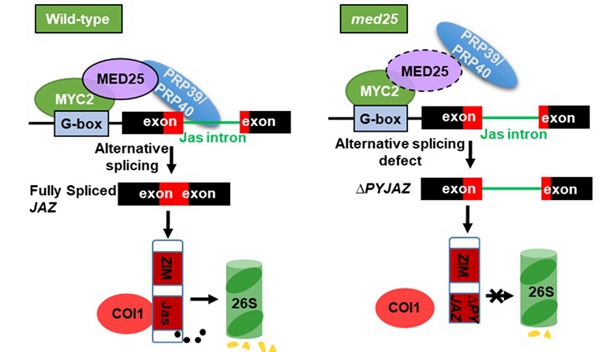As an important plant hormone, jasmonate (JA) controls resource allocation between growth- and defense-related processes, thus plays a critical role in optimizing plant adaptation to their rapidly changing and often hostile environments. Therefore, both the activation and the deactivation/desensitization of JA responses must be under tight control.
It is well recognized that JA-induced production of dominant JAZ splice variants provides a general mechanism to desensitize JA responses. However, it is unclear how plants control the generation of dominant JAZ splice variants to proper levels to prevent excessive and/or uncontrolled desensitization of JA signaling. Prominently, the splicing factors involved in Jas intron-dependent alternative splicing (AS) of JAZ genes and how these splicing factors are recruited remain enigmatic.
Recently, a team led by Prof. LI Chuanyou at the Institute of Genetics and Developmental Biology, Chinese Academy of Sciences, revealed a mechanistic function of the Mediator subunit MED25 in coupling the AS of JAZ genes with fine tuning of jasmonate signaling.
They found that JA-induced production of dominant JAZ splice variants depends on the functions of the transcription factor MYC2 and MED25. Using affinity purification and mass spectrometry, they found that PRE-mRNA-PROCESSING PROTEIN 39a (PRP39a) and PRP40a, two subunits of the evolutionarily conserved spliceosomal U1 small nuclear ribonucleoprotein particle (snRNP) involved in co-transcriptional AS, are components of MED25-MYC2 functional Complex (MMC).
They demonstrated that MED25 controls JA-induced recruitment of PRP39a and PRP40a to JAZ loci to facilitate the full splicing of Jas intron. Therefore, the MED25-PRP39a/PRP40a module plays a critical role in preventing JAZ splice variants-mediated excessive desensitization of JA signaling.
This study exemplifies how a Mediator subunit integrates the effects of general splicing factors into a specific signaling pathway to accurately control gene expression.
This study supports a scenario that the “multitalented” MED25 acts as a central coactivator of MYC2-dependent transcriptional regulation of JA signaling in a highly organized manner.
The paper entitled “Mediator Subunit MED25 Couples Alternative Splicing of JAZ Genes with Fine Tuning of Jasmonate Signaling” was published in
The Plant Cell on, Deccember19, 2019 (
doi:10.1105/tpc.19.00583).
This study was supported by grants from the Chinese Academy of Sciences, the National Key R&D Program of China, and the National Natural Science Foundation of China.
Figure: MED25 regulates the alternative splicing of JAZ genes through recruiting splicing factors (Image by IGDB)
Contact:
QI Lei
Institute of Genetics and Developmental Biology, Chinese Academy of Sciences
 Figure: MED25 regulates the alternative splicing of JAZ genes through recruiting splicing factors (Image by IGDB)Contact:QI LeiInstitute of Genetics and Developmental Biology, Chinese Academy of SciencesEmail: lqi@genetics.ac.cn
Figure: MED25 regulates the alternative splicing of JAZ genes through recruiting splicing factors (Image by IGDB)Contact:QI LeiInstitute of Genetics and Developmental Biology, Chinese Academy of SciencesEmail: lqi@genetics.ac.cn CAS
CAS
 中文
中文




.png)
